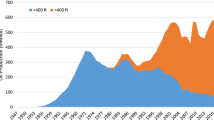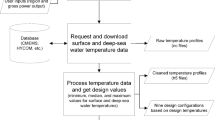Abstract
Quantifying the change in field expected ultimate recovery across time is an old and complex topic fraught with ambiguity and misinterpretation. In this paper, changes in recovery estimates performed by the Bureau of Ocean Energy Management in the US Gulf of Mexico are evaluated based on 782 offshore fields that began producing after 1975 and ceased production before 2017. At the time of first production, field expected ultimate recovery estimates totaled 6.3 billion barrels oil equivalent (38.6 exajoules), but by the end of their life, the fields produced 8.5 billion barrels oil equivalent (52 exajoules), a 35% growth. On an individual field basis, however, median recovery estimates grew less than 2%. The purpose of this paper is to explain the differences in these two statistics and quantify how expected ultimate recovery is influenced by field age, discovery year, reserve category, peak ratio, product type, size, and water depth to understand better the contribution of individual factors in reserves evaluation. Consistent interpretation of reserves category is probably the most important factor in application. Field age and size are positively correlated with changes in expected ultimate recovery in both the shallow water and deepwater regions of the US Gulf of Mexico, pre- and post-1988 evaluation periods are a significant factor, and a development variable referred to as peak ratio exhibits a meaningful correspondence. The results of this analysis show that Bureau of Ocean Energy Management procedures for expected ultimate recovery estimation in the US Gulf of Mexico post-1988 are consistent with the application of probable reserves classifications; these highlight the need for a precise understanding of factor inputs in reserves growth studies.


Source: Data from BOEM (2020)

Source: BOEM

Source: Data from BOEM (2018)
Similar content being viewed by others
Notes
Previous studies often combine producing and idle fields in evaluation, and although it is easy to accommodate in the methodological framework, it is not the approach taken here.
On a heat-equivalent basis, 1 boe = 6.12 million kilojoules = 6.12 × 109 J. 1 petajoule (PJ) = 1 x 1015 J; 1 exajoule (EJ) = 1 x 1018 J. On a volume basis, 6.29 barrels crude = 1 cubic meter (m3).
BOEM officially uses a 1000 ft (305 m) water depth threshold to demarcate deepwater and 5000 ft (1524 m) water depth for ultra-deepwater.
Companies perform reserves estimates regularly (annually or semi-annually) and report aggregate P1 estimates according to specific business units (e.g., country, region) in financial reports according to the regulatory requirements of the stock exchange in which its shares are listed.
Email correspondence with Eric Kazanis, BOEM geologist. Sept 12, 2018; April 17, 2020.
All fields have the same opportunity to benefit from new technology but, in practice, many differences arise depending on operator size and risk tolerance, capital budgets, geologic conditions, etc. Most of these conditions are unknown, unobservable, or not easily measured, so the use of discovery year as a proxy of technology application or similar metric, which is common practice in economic studies, is unlikely to be beneficial.
In this study, higher EUR growth in GoM fields was shown to be more closely associated with reservoir area than with its thickness for non-piercement salt traps, and fields that grew the most were those in which the largest reservoir was not the first discovered.
References
Arrington, J. R. (1960). Predicting the size of crude reserves is key to evaluating exploration programs. Oil & Gas Journal, 58(9), 130–134.
Attanasi, E. D., & Coburn, T. C. (2004). A bootstrap approach to computing uncertainty in inferred oil and gas reserve estimates. Natural Resources Research, 13, 45–52.
Attanasi, E. D., & Root, D. H. (1994). The enigma of oil and gas field growth. AAPG Bulletin, 78(3), 321–332.
BOEM. (1996). Field Naming Handbook. Bureau of Ocean Energy and Management (BOEM). Retrieved September 2019 from https://www.boem.gov/BOEM-Newsroom/Offshore-Stats-and-Facts/Gulf-of-Mexico-Region/Field-Naming-Handbook-March-1996.aspx.
BOEM (2018a). OCS operations field directory. Bureau of Ocean Energy and Management (BOEM). Quarterly Report, December 31, 2017. https://www.boem.gov/Operations-Field-Directory/.
BOEM (2018b). Reserves history for fields. Gulf of Mexico Outer Continental Shelf. Bureau of Ocean Energy and Management (BOEM) Gulf of Mexico OCS Region. December 31, 2016.
Burgess, G.L., Kazanis, E.G., & Cross, K.K. (2018). Estimated Oil and Gas Reserves, Gulf of Mexico OCS Region, December 31, 2016. New Orleans, LA: Bureau of Ocean Energy Management, OCS Report BOEM 2018-034. US Department of Interior. Retrieved September 2019 from http://www.boem.gov/BOEM-2018-034/.
Burgess, G.L., Kazanis, E.G., & Shepard, N.K. (2016). Estimated Oil and Gas Reserves, Gulf of Mexico OCS Region, December 31, 2015. New Orleans, LA: Bureau of Ocean Energy Management, OCS Report BOEM 2016-024. US Department of Interior. Retrieved February 2018 from http://www.boem.gov/BOEM-2016-082/.
Cook, T. A. (2013). Reserves growth of oil and gas fields—Investigation and applications. Denver, CO: US Geological Scientific Investigations Report 2013-5063. US Department of Interior. Retrieved September 2019 from http://pubs.usgs.gov/sir/2013/5063/.
Drew, L. J., & Lore, G. L. (1992). Field growth in the Gulf of Mexico—A progress report, in Carter, L. M. H., ed., USGS Research on Energy Resources, 1992, Program with Abstracts: US Geol. Survey Circ., 1074, 22–23.
Drew, L. J., Mast, R. F., & Schuenemeyer, J. H. (1994). The space-time structure of oil and gas field growth in a complex depositional system. Nonrenewable Resources, 3(3), 170–182.
Grace. J.D. (2006). A closer look at field reserve growth: science, engineering or just money? In Slatt, R.M., Rosen. N.C., Bowman, M., Castagna, J., Good, T., Loucks. R., Latimer, R., Scheihing. M., & Smith, R. (Eds.) Reservoir Characterization: Integrating Technology and Business Practices, 26th Annual Gulf Coast Section Society of Sedimentary Geologists (GCSEPM) Bob F. Perkins Research Conference, December 3–6, pp. 1-23.
Hubbert, M. K. (1967). Degree of advancement of petroleum exploration in United States. AAPG Bulletin, 51(11), 2207–2227.
Kaiser, M. J. (2016). Development strategies and profitability assessment of semisubmersible production units in the Gulf of Mexico, Chapter 21. In M. R. Riazi (Ed.), Exploration and Production of Petroleum and Natural Gas. PA: ASTM International, Mayfield.
Kaiser, M. J. (2019). Decommissioning Forecasting and Operating Cost Estimation. Cambridge, MA: Gulf Professional Publishing.
Kaiser, M. J., & Narra, S. (2019). A retrospective analysis of field discovery and development in the US Gulf of Mexico, 1947-2017. Natural Resources Research, 28(3), 685–715.
Klett, T. R., & Gautier, D. L. (2005). Reserve growth in oil fields of the North Sea. Petroleum Geoscience, 11(2), 179–190.
Klett, T. R., & Schmoker, J. W. (2003). Reserve growth of the world’s giant oil fields. In Halbouty, M.T. (Ed.) Giant oil and gas fields of the decade 1990–1999: Am. Assoc. Petroleum Geologists Mem (Vol. 78, pp. 107–122).
Morehouse, D. F. (1997). The intricate puzzle of oil and gas ‘reserves growth’. Natural Gas Monthly, July: Energy Information Administration.
Petroleum Resources Management System (PRMS). (2007). Society of Petroleum Engineers. Retrieved January 2019 from https://www.spe.org.
Root, D. H. (1981). Historical growth of estimates of oil and gas field sizes. In S. I. Gauss (Ed.), Oil and Gas Supply Modeling (pp. 350–368). Washington, DC: National Bureau of Standards.
Root, D. H., & Attanasi, E. D. (1993). A primer in field-growth estimation. In: Howell, D. G. (Ed.) The future of energy gases: US Geol. Survey Prof. Paper (Vol. 1570, pp. 547–554).
Root, D. H., & Mast, R. F. (1993). Future growth in known oil and gas fields. American Association of Petroleum Geologists Bulletin, 77(3), 479–484.
Schmoker, J. W., & Klett, T. R. (2000). Estimating potential reserve growth of known (discovered) fields: A component of the USGS World Petroleum Assessment 2000, in US Geological Survey World Energy Assessment Team, eds., US Geological Survey World Petroleum Assessment 2000: US Geol (p. 20). Survey Digital Data Series DDS-60, 4 CD-ROMs.
Verma, M. K., Ahlbrandt, T. S., & Al-Gailani, M. (2004). Petroleum reserves and undiscovered resources in the total petroleum systems of Iraq: Reserve growth and production implications. GeoArabia, 9(3), 51–74.
Verma, M. K., & Ulmishek, G. F. (2003). Reserve growth in oil fields of West Siberia basin Russia. Natural Resources Research, 12(2), 105–119.
Author information
Authors and Affiliations
Corresponding author
Rights and permissions
About this article
Cite this article
Kaiser, M.J. Evaluation of Changes in Expected Ultimate Recovery for US Gulf of Mexico Oil and Gas Fields, 1975–2016. Nat Resour Res 30, 1229–1252 (2021). https://doi.org/10.1007/s11053-020-09756-7
Received:
Accepted:
Published:
Issue Date:
DOI: https://doi.org/10.1007/s11053-020-09756-7













